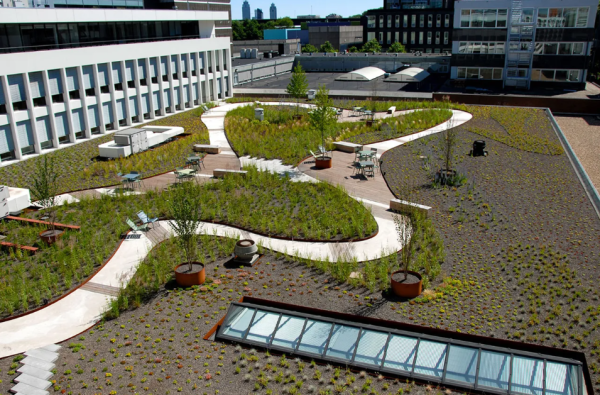Amszterdamban 45.000 négyzetméternyi kék-zöld tető található, amelyek “elnyelik” az esővizet, és lehetővé teszik, hogy az épületek lakói növények öntözésére és WC-öblítésre használják azt, ahelyett, hogy azonnal a csatornarendszert terhelnék vele.
Amszterdamot talán a csatornái miatt látogatod meg, és valóban, ki hibáztathatna ezért? De az igazán érdekes vízi utak nem a lábad alatt – hanem a fejed felett vannak.
Gyönyörű zöld tetők bukkantak fel szerte a világon: speciálisan kiválasztott növények nőnek a biomassza extra súlyának elbírására tervezett szerkezeteken. Amszterdam azonban egy lépéssel tovább ment ennél a kék-zöld tetőkkel, amelyeket kifejezetten az esővíz felfogására terveztek. Az egyik ilyen projekt – az intelligens, innovatív, az éghajlathoz alkalmazkodó tetők reziliens hálózata (Resilio) – több mint 9.000 négyzetmétert fedett le Amszterdam tetőin, köztük 8.000 négyzetmétert szociális lakóparkokon. Városszerte a kék-zöld tetők lefedettsége még ennél is nagyobb, becslések szerint több mint 45.000 négyzetméter.
A „szivacsváros” koncepció egyre népszerűbb. A településfejlesztők egyre több zöldterületet telepítenek, amelyek szivacsként felszívják a globális felmelegedéssel egyre hevesebbé váló felhőszakadások okozta csapadékot. Ez egyidejűleg csökkenti a villámárvizek hatását és feltölti a nedvszívó kőzetréteget is. Míg korábban a városokat úgy tervezték, hogy az esővizet a lehető leggyorsabban elvezessék, egyre inkább a helyben tartás a cél, erőforrásként használva a vizet.
A szivacsvárosok nagy kihívása, hogy a városi területek nagy része háztető. A zöld tetők felszívják az esővizet, hogy hidratálják a növényeket, de a kék-zöld tetők egy lépéssel tovább mennek, olyan infrastruktúrával, amely összegyűjti a csapadékot, tárolja, és az épület lakói számára hozzáférhetővé teszi a növények öntözésére és a WC-öblítésre.

A rendszer réteges kialakítást igényel. A felszínen növények találhatók: mohák, cserjék, füvek, páfrányok, gyógynövények és varjúháj félék, egy szívós nemzetség, amely a zöldtetők egyik alapanyaga. (Bár a növényeknek napfényre van szükségük a túléléshez, egy tetőn túl sok fény, meleg és szél érheti őket, a megfelelő növényválasztás ezért kulcskérdés.). A növények a talajban gyökereznek, tápanyagot és támaszt nyújtanak.
A növényréteg alatt egy szűrőréteg található, amely megakadályozza, hogy a talaj a következő rétegbe kerüljön: ez egy könnyű ládarendszer, amely a vizet tárolja. Alatta pedig további rétegek vannak, amelyek megakadályozzák, hogy a víz és a növények gyökerei a tényleges tetőt károsítsák. „Tulajdonképpen egy lapos esőtartály van a tetőn” – mondja Kasper Spaan, a Resilio programban részt vevő amszterdami Waternet vízgazdálkodási közszervezet klímaadaptációval foglalkozó szakpolitikai fejlesztője.
A kék-zöld tető vízszintjét egy intelligens szelep szabályozza. Ha az előrejelzés szerint vihar közeleg, a rendszer idő előtt kiengedi a tetőn tárolt vizet. Így amikor jön a felhőszakadás, a “szivacstető” újra megtelik, ami azt jelenti, hogy kevesebb esővíz kerül a környék ereszcsatornán keresztül a csatornákba. Más szóval a tető egy szivaccsá válik, amelyet szükség szerint ki lehet csavarni. „A »kifacsarható« szivacsvárosban az egész várost formálhatóvá tesszük” – mondja Spaan.
Ez rugalmasabbá, de egyben bonyolultabbá is teszi a csapadékvíz-gazdálkodás hagyományos rendszerét. Ezért a Resilio projekt az Autodesk szoftverét használta fel a kék-zöld tetők hatásának és az amszterdami árvízkockázatnak a modellezésére, az éghajlati megoszlást is figyelembe véve.
„Megnézhetjük a történelmi árvízi mintákat, majd szimulációkat végezhetünk, amelyek segítenek megérteni a folyamatokat. Amennyi kapacitást kivehetek a vízelvezető hálózatból, a vihar bekövetkezésekor annyival – akár 10-20%-kal is – csökkentem a villámárvizek hatását” – mondja Amy Bunszel, az Autodesk építészeti, mérnöki és építőipari tervezési megoldásokért felelős ügyvezető alelnöke.

A szivacsvárosi előnyökön túl a kék-zöld tetők egyúttal hűtik is az épület legfelső szintjét, lényegében „kiizzadva”, vagyis elpárologtatva a tárolt víz egy részét. A megfelelő őshonos növényfajtákkal segíthetik az élővilágot azáltal, hogy gondoskodnak az őshonos beporzó rovarokról. A tudósok még egy lépéssel tovább mennek, és kísérleteznek azzal is, hogy a tetőkön napelemek alatt termesszenek növényeket. Ez az úgynevezett agrivoltaika. Elméletileg, ha ezt kék-zöld rendszerekkel párosítjuk, akkor a párolgó vízzel történő hűtés révén javulhat a napelemek hatékonysága is.
Nem minden épület lehet azonban kék-zöld. Maga az infrastruktúra nem túl nehéz, de a benne lévő víz igen. Így míg a rendszert viszonylag olcsón és könnyen be lehet építeni az új építkezéseknél, a régebbi épületeknél szükség lehet a rendszer utólagos átalakítására, figyelembe véve a többletsúlyt. Hosszú távon azonban pénz takarítható meg azáltal, hogy csökken a városi rendszerből vásárolt víz mennyisége. Mint minden technológiának, várhatóan ennek is csökkenni fognak a költségei, ahogy egyre szélesebb körben alkalmazzák.
Az elképzelés az, hogy az egyre súlyosbodó aszályokkal és árvizekkel küzdő helyeken nemcsak a talajon – például szárazságtűrő növényekkel borított földfoltokon, amelyek a csapadékvizet a víztartó rétegekbe szívják fel -, hanem az épületek tetején is alkalmazzák a szivacsvárosi koncepciót. „Úgy gondoljuk, hogy a koncepció a világ számos városi területére alkalmazható” – mondja Spaan. „Európa déli részén – Olaszországban és Spanyolországban -, ahol valóban szárazság sújtotta területek vannak, új figyelem irányul az esővízgyűjtésre.”
A városok akár adókedvezményekkel is ösztönözhetnék a kék-zöld tetők építését, jutalmazva az épület tulajdonosait, ha csökkentik a túlterhelt csatornákba jutó csapadékvíz mennyiségét. Az Egyesült Államokban, például Los Angelesben és Pittsburghben már bevezettek valami hasonlót: adót vetnek ki az ingatlanon lévő olyan területre, melyekről a csatornákba jut a víz, így ösztönözve a telektulajdonosokat kertek és egyéb zöldfelületek kialakítására.
A jövő városa tehát nem a sci-fi betonba burkolt metropolisza, hanem egy egyre zöldebb és szivacsosabb táj, amelyet szükség esetén “ki lehet facsarni”. „A mi filozófiánk végső soron nem az, hogy minden tetőn lehetséges minden” – mondja Spaan – „hanem az, hogy minden tetőn lehetséges valami”.


Forrás: https://www.wired.com/
Fotók: https://resilio.amsterdam/







Hagyj üzenetet